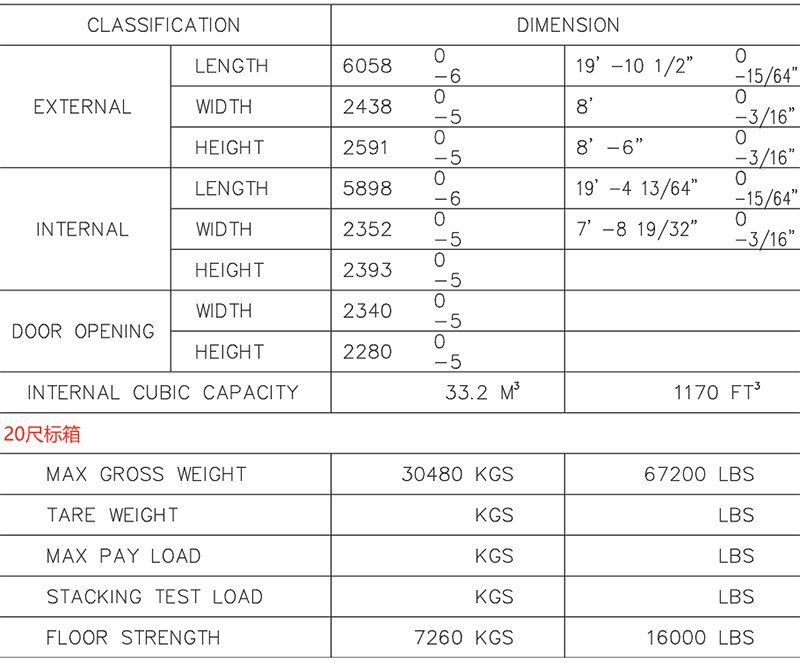The 20-foot container is a ubiquitous and highly adaptable asset in the fields of transportation, storage, and various industries. This detailed description will cover its specifications, materials, construction, and a wide range of application scenarios.
1. Specifications
External Dimensions: The standard length of a 20-foot container is exactly 20 feet, which is approximately 6.096 meters. The width measures 8 feet, equivalent to 2.438 meters. The height is typically 8 feet 6 inches, around 2.591 meters. These dimensions are widely recognized and adhered to in the shipping and logistics industry, allowing for seamless integration into various transportation and storage systems.
Internal Dimensions: The internal length is around 19 feet 4 inches, about 5.89 meters. The width is approximately 7 feet 8 inches, or 2.34 meters. The height is roughly 7 feet 10 inches, which is 2.39 meters. The internal volume is approximately 33 cubic meters, providing a significant amount of space for storing and transporting a diverse array of goods.
Weight Capacity: It has a maximum payload capacity that usually ranges from 24,000 to 28,000 kilograms. This robust weight-bearing capacity enables it to handle heavy loads, making it suitable for transporting everything from industrial machinery to bulk commodities.
Door Dimensions: The container is equipped with a single door at one end. The door has a width of about 7 feet, approximately 2.134 meters, and a height of 6 feet 8 inches, around 2.032 meters. This door size is designed to facilitate the loading and unloading of standard-sized cargo pallets and a wide variety of goods.
2. Materials and Construction
Frame: The frame of the 20-foot container is constructed from high-strength steel. This steel is carefully chosen for its excellent tensile and compressive strength, ensuring the container can withstand the rigors of transportation, including being lifted, stacked, and subjected to vibrations during transit. The steel is also treated with anti-corrosion coatings to protect against rust and degradation, prolonging the container's service life and maintaining its structural integrity.
Wall and Roof Panels: The walls and roof are made of corrugated steel sheets. The corrugated design not only adds aesthetic appeal but also significantly enhances the structural rigidity of the container. These sheets are firmly attached to the frame and are highly resistant to external impacts and pressure. They provide a reliable barrier against the elements, protecting the contents from rain, wind, sunlight, and other environmental factors.
Floor: The floor is typically made of hardwood or a combination of plywood and steel. Hardwood floors are renowned for their durability and ability to support heavy weights. They are often treated to resist moisture and pests. The steel reinforcements underneath the floor enhance its strength, preventing it from sagging under heavy loads and ensuring a stable platform for cargo.
Doors: The door is made of steel and is hinged to the frame. It is equipped with a reliable locking mechanism to ensure the security of the cargo during transit. The door is designed to open and close smoothly, with weather seals to prevent the ingress of water, dust, and air, thereby protecting the contents of the container.
3. Usage Scenarios
Logistics and Freight Transportation: The 20-foot container is the workhorse of the shipping industry. It is used to transport a vast range of goods, from consumer products and electronics to automotive parts and building materials. Its standardized size allows for efficient loading onto ships, trucks, and trains, facilitating global trade and supply chain management.
Storage: It serves as an excellent storage solution for both short-term and long-term needs. Businesses can use it to store inventory, equipment, and archived documents. Homeowners can also utilize it for storing seasonal items, furniture, and personal belongings. The container's weatherproof and secure design ensures the protection of stored items.
Temporary Structures: Can be converted into temporary offices, workshops, or living quarters. With some interior modifications such as insulation, electrical wiring, and plumbing, it becomes a functional and mobile space. It is commonly used on construction sites, at events, and in disaster relief efforts.
Retail and Pop-Up Stores: Can be transformed into a unique retail space or a pop-up store. By adding shelves, display racks, and lighting, it becomes an eye-catching and convenient location for selling products. It is popular in shopping malls, at festivals, and in urban areas with high foot traffic.





